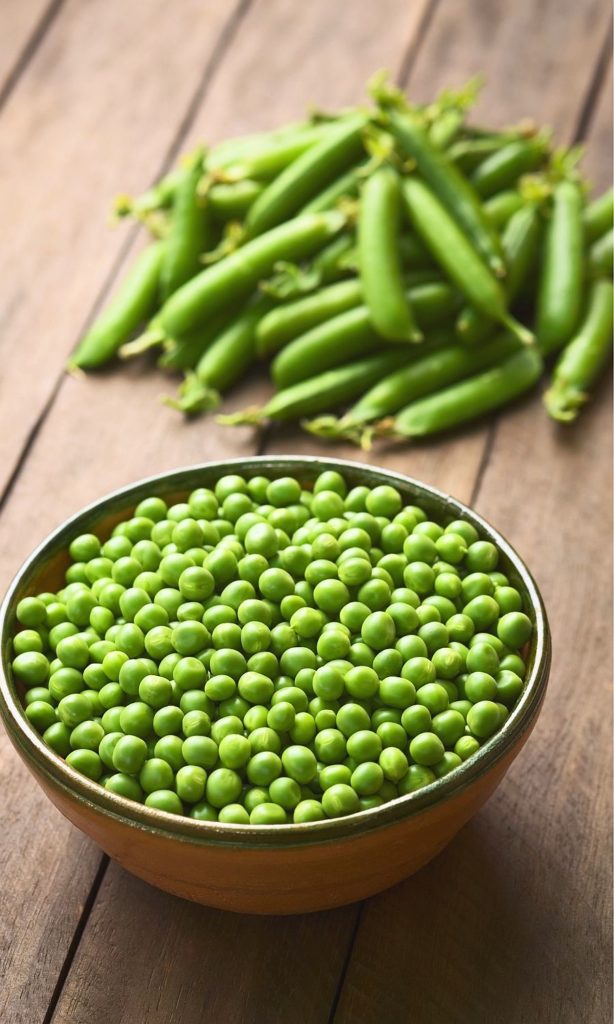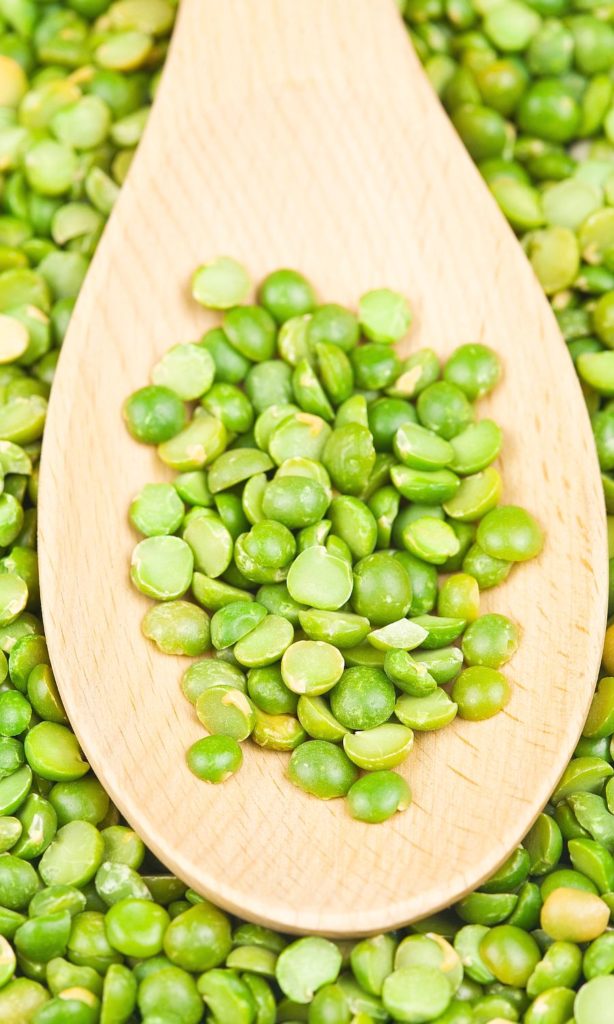Peas for dogs are a legume crop high in protein and starch. Peas for dogs can be a nutritious vegetable but are also a controversial ingredient currently under investigation.
There are green and yellow varieties of split peas and whole dried field peas. And manufacturers can use by-products like pea flour, pea fiber, pea starch, or pea protein in their products.
Contents
What are Peas?
The common pea (Pisum sativum) is a widely cultivated and one of the oldest and most important domesticated legume crops.
Today, peas are mainly grown in China, India, Canada, Russia, France, and the United States[2].
Peas form their seeds in pods, each of which contains several peas. Peas are legumes used as vegetables and in animal feed.
Green garden peas are harvested while still immature to be eaten as a vegetable. And sugar peas like the snow pea or snap pea have thin pod walls and flat pods and are harvested whole.

Cultivars used for animal food are usually field peas which can have green or yellow seeds and are harvested ripe.
They are sold as dried peas or are used as split peas in dog food after their indigestible skins are removed.
There are some cultivars of field peas known as protein peas.
Some people think that yellow peas in dog food are different than green peas in dog food. But all kinds of peas come in different colors which do not provide any indication of their nutritional value!

Plants like chickpeas (Cicer arietinum), black-eyed peas and cowpeas (Vigna unguiculata) or sweet peas (Lathyrus odoratus) are only “peas” in name but belong to different groups of legumes.
Purpose Of Peas in Dog Food
Can dogs eat peas?
Yes, as a vegetable, garden peas provide vitamins, minerals, and some phytonutrients like carotenes, lutein or zeaxanthin.
But although marketed as a vegetable, dried peas in dog food are a multi-purpose ingredient and provide protein, fiber, and energy.

Overall, most dog food manufacturers like protein peas and other dried field peas as a novel carb and protein source.
Due to the increased need for sustainable protein and the emergence of limited-ingredient recipes and plant-based diets peas have increased in popularity in recent years.
For dog food products […] flaxseed, peas and carrots are the top three most commonly used plant ingredients
Pet Food Production and Ingredient Analysis 2020[1]
Peas (not even including split peas, green peas and pea flour) are by far the most widely used specialty ingredient in dog foods in recent years, based on industry reports.
Peas are used as a more appealing alternative to soybean or grains in many recipes. And of course, they are cheaper and more available compared to animal-based protein sources.

Field peas or split peas are high in protein, dietary fiber, starch, and complex carbohydrates while low in fat[12,15].
Pea protein can also improve the texture of dog food.
Dried peas and green peas contain a moderate amount of purines, if that’s important to your dog.
But there are so many different cultivars that it’s impossible to determine the nutritive value of peas used in a particular recipe.
Whole peas or pea flour for dogs are a nutrient-dense ingredient. Although we consider it to be of lower quality than animal proteins dogs can eat peas.
They are highly digestible but since they are rich in resistant starch they may improve metabolic health and insulin response in overweight dogs[7,11].
Pea Ingredients in Dog Food
Many ingredient lists simply mention that they include some kind of peas like dried peas, green peas, yellow peas, or field peas.
Typically, all of these ingredients are just names for dehulled dried field peas which might be split or not. So it doesn’t make all that much difference if a recipe features yellow split peas or green peas, etc.
There are also several refined pea by-products available to manufacturers[3]:
- Pea flour is obtained by grinding dehulled roasted peas. Ground pea powder for dogs contains a minimum of 20% crude protein in dry matter.
- Pea protein in dog food offers at least 53% crude protein in dry matter and is extracted from yellow or green split peas. Dog food with pea protein is highly digestible but has to be supplemented with other amino acid sources since it’s high in lysine but deficient in tryptophan and methionine[4,14].
- Pea starch is what’s left after pea protein is removed during pea processing. This ingredient contains a minimum of 65% dietary starch in dry matter.
- Pea fiber is a by-product of dry milling. Pea fiber for dogs contains at least 23% crude fiber in its dry matter.

Are Peas Good For Dogs?
So, let’s talk about dogs and peas and health.
First of all, legumes like peas are known to contain some anti-nutritional factors.
Raw pea ingredients inhibit enzymes in the digestive system. They contain tannins that are known to reduce protein digestibility and lectins that interfere with digestion.
And Peas in pet food undergo some form of heat treatment and processing making them edible to dogs. Many cultivars of peas are bred to contain lower amounts of problematic substances.
But we don’t recommend feeding raw field peas to dogs, they have to be cooked first. But small amounts of green garden peas or snow peas don’t seem to cause issues.
It’s still hard to say if peas are really safe for dogs.
That’s because they are one of the ingredients most commonly linked to nutrition-mediated canine dilatative cardiomyopathy[10].
As a novel specialty ingredient their use in dog food is not as well-researched as that of other foods.
A 2021 study looking at more than 800 compounds in dog foods warned peas and lentils may be ingredients linked to canine heart disease[5].
Peas contain more soluble fiber compared to cereal grains. And pea inclusion affects the fecal microbiome in dogs[13].
But we don’t know yet if this has any implications for gut health or how this maybe affects the metabolism or bioavailability of other nutrients.
In conclusion, we won’t go so far as to say peas are dangerous for dogs when used in moderation. But we don’t recommend feeding a diet rich in peas at this moment.
Further Reading
[1] Pet Food Production and Ingredient Analysis (PDF). 2020. Institute for Feed Education and Research (IFEEDER), North American Renderers Association (NARA), Pet Food Institute (PFI)
[2] FAO 2017. Pulses and their by-products as animal feed (PDF). Chapter 6: Peas.
[3] AAFCO Official Publication. Chapter 6. Free Access.
[4] Feedipedia: Pea Seeds. 2015
[5] Smith et al. Investigation of diets associated with dilated cardiomyopathy in dogs using foodomics analysis. Sci Rep . 2021. https://doi.org/10.1038/s41598-021-94464-2
[6] Bakke et al. Responses in randomised groups of healthy, adult Labrador retrievers fed grain-free diets with high legume inclusion for 30 days display commonalities with dogs with suspected dilated cardiomyopathy. BMC Vet Res. 2022. https://doi.org/10.1186/s12917-022-03264-x
[7] Carciofi et al. Effects of six carbohydrate sources on dog diet digestibility and post-prandial glucose and insulin response. Journal of Animal Physiology and Animal Nutrition. 2008. https://doi.org/10.1111/j.1439-0396.2007.00794.x
[8] Mansilla et al. Special topic: The association between pulse ingredients and canine dilated cardiomyopathy: addressing the knowledge gaps before establishing causation. Journal of Animal Science. 2019. https://doi.org/10.1093/jas/sky488
[9] Freeman et al. Diet-associated dilated cardiomyopathy in dogs: what do we know? Journal of the American Veterinary Medical Association. 2018. https://doi.org/10.2460/javma.253.11.1390
[10] Ontiveros et al. Development of plasma and whole blood taurine reference ranges and identification of dietary features associated with taurine deficiency and dilated cardiomyopathy in golden retrievers: A prospective, observational study. PLoS ONE. 2020. https://doi.org/10.1371/journal.pone.0233206
[11] Adolphe et al. Effect of an extruded pea or rice diet on postprandial insulin and cardiovascular responses in dogs. Animal Physiology and Animal Nutrition. 2014. https://doi.org/10.1111/jpn.12275
[12] Bednar et al. Starch and Fiber Fractions in Selected Food and Feed Ingredients Affect Their Small Intestinal Digestibility and Fermentability and Their Large Bowel Fermentability In Vitro in a Canine Model. The Journal of Nutrition. 2001. https://doi.org/10.1093/jn/131.2.276
[13] Sandri et al. Substitution of a commercial diet with raw meat complemented with vegetable foods containing chickpeas or peas affects faecal microbiome in healthy dogs. Italian Journal of Animal Science. 2019. https://doi.org/10.1080/1828051X.2019.1645624
[14] Reilly et al. Macronutrient composition, true metabolizable energy and amino acid digestibility, and indispensable amino acid scoring of pulse ingredients for use in canine and feline diets. Journal of Animal Science. 2020. https://doi.org/10.1093/jas/skaa149
[15] Traughber et al. Chemical Composition and In Vitro Fermentation Characteristics of Legumes Using Canine Fecal Inoculum. Journal of Animal Science. 2020. https://doi.org/10.1093/jas/skaa278.572
